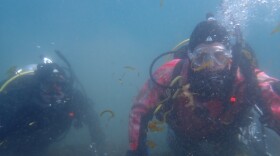Kodiak’s Buskin Lake and river of the same name is usually a quiet place for folks to fish for salmon, but on Sept. 21, dozens of people came to walk around the water and look for invasive crayfish.
Kayla McDermott came by with her spouse and two sons. She said she had to balance catching crayfish with catching her kids.
“It’s kind of like the same thing a little bit! It was like, once you see them, and then they disappear and they’re super fast,” she said.
It’s the third derby of the year but McDermott and her family’s first time coming to one. She said she was probably more interested in catching shellfish than her kids were though.
“I only got two, and they were okay,” she said. “They weren’t super big, but they were still pretty good size, I’d say.”

Altogether, volunteers pulled hundreds of crayfish out of the water, and this is just the latest derby in four years of the community trying to control the population this way. It’s just one way the community is working to control the invasive species, at the only place in the state that has crayfish.
The invasive species was first found in the river about 22 years ago though. No one knows exactly how or why they were introduced, but they’ve long been suspected to have an impact on the native salmon populations.
Daniel Smith is a biologist with the Sun’aq Tribe of Kodiak and is working on his doctorate degree on that topic.
“The project is specifically looking at the population dynamics of signal crayfish on the Buskin River Watershed and the ecological and functional role of signal crayfish, and the direct and indirect effects on salmon,” he said.
Smith is basically trying to get a better idea of where the crayfish are, what they eat, and how they fit into the bigger picture.
“What we’re seeing from the data is that they are basically homebodies in the areas that we had originally tagged and re-released them,” he said. “Which is good for us, because we don’t want this invasive species to migrate.”

Smith said one problem is crayfish eating salmon carcasses after they’ve spawned. That removes nutrients the anadromous fish bring back from the ocean after they stay upstream, which benefits the ecosystem.
The tribe’s natural resources director, Matt Van Daele, said they wanted to host a fall derby because those months are when the crayfish are most active.
“This would be a prime opportunity to catch a lot of adult crayfish because it’s the breeding season and so all the adults are up and about,” he said.

Van Daele said derbies like this one are one way to keep the community invested in keeping crayfish populations down.
"Grants will dry up, people will begin to lose interest, so how can we keep public interest and keep everybody’s eyes on the ball of dealing with this?" he said.

He said the Tribe’s current grant to manage the crayfish population and to consider long term control and sustainability plans.
For McDermott and her kids though, they’re just excited to be part of it and learn from folks who’ve done more derbies than they have.
“I can tell a lot, or at least some, of the kids have been out here quite a few times because they were like ‘oh I know how to handle them,’” she said. “They have the gloves and everything – I see they’re well prepared, they know what they’re doing.”
She said she’s already excited to catch more crayfish at another derby. The next one is slated for October.




